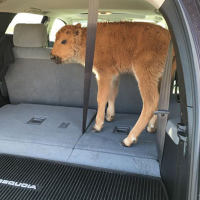“Epidemic” of Public Interaction with Wildlife Puts Animals in Peril
 Tourists put this baby bison in their car to warm it up (photo: Karen Richardson via Facebook)
Tourists put this baby bison in their car to warm it up (photo: Karen Richardson via Facebook)
By Christopher Mele, New York Times
For people who feel compelled to get up close and personal with wildlife, advocates and national park officials have a message: Dr. Doolittle is only in the movies.
A recent episode in which a bison calf at Yellowstone National Park was euthanized after being placed in the back of an SUV is one example of the dire consequences of a widespread and common occurrence: humans interacting inappropriately with wild animals, officials said.
Such encounters are fueled by the culture of selfies, along with ignorance about nature, and they lead to encounters that are dangerous to both people and animals.
Death of a Baby Bison
In the most recent case, tourists took the animal in their vehicle to a ranger station because they thought it was cold, a Montana television station reported.
The calf was killed because it was later rejected by its herd and began “continually approaching people and cars along the roadway,” the National Park Service said in a statement.
People see young animals alone in the wild and immediately assume they need rescuing, said Kathy Uhler, the director of the Pocono Wildlife Rehabilitation and Education Center in Stroudsburg, Pennsylvania. Uhler said the public needed to be reminded constantly to leave animals in their place.
She called the inappropriate interactions with wildlife “an epidemic.”
Uhler recalled members of a Pennsylvania family who picked up a bear cub, put a leash on it and walked it around their yard. Then there was the woman who nursed a baby raccoon that she thought had been abandoned.
“We can’t make these stories up,” said Uhler, who has been working with injured and orphaned wild animals with her husband, Eric, for 36 years.
In some cases, people act out of compassion because they believe animals are in distress, said Kai Williams, the executive director of the International Wildlife Rehabilitation Council in Eugene, Oregon, which promotes wildlife conservation.
Williams cited cases of coyotes, deer, foxes and owls being transported on people’s laps in cars to veterinarians or wildlife rehabilitators. She said the animals usually remain still and allow themselves to be held close because they go into shock.
“The human will see it as ‘Wow, they really like me,’ and what’s going on is this incredibly complex stress response within the animal that can often be life-threatening,” she said.
The Bleating Moose Calf
In May 2015 in Montana, a moose calf walked up to a camper who found it in the woods near the carcasses of its mother and another calf, who had both died during childbirth, The Bozeman Daily Chronicle reported.
The calf was bleating, and the camper took it to fish and wildlife officials, thinking it would be cared for or relocated.
Instead, officials killed the calf, saying they were following protocol because relocating a moose risks spreading diseases, and the calf would have died without its mother.
The U.S. Forest Service then used explosives to blow up the three carcasses, spreading the remains so they would not attract predators such as grizzly bears at the campground, The Chronicle reported.
Passing Around Baby Dolphin for Photos
When not acting out of compassion, people act out of selfishness about what is best for them, not the animals, Uhler said.
Such was the case in February, when beachgoers picked up a baby dolphin in Argentina and passed it around for photos and petting. It died after being left in the mud.
“People like to share their experiences,” Williams said. “To say, ‘I did this, this happened,’ it maybe does make people take more risks.”
Such sharing on social media has driven tourists at Yellowstone to get very close to wild animals, particularly bison, with #bisonselfie becoming a popular topic on Twitter and Instagram.
The National Park Service instructs visitors to Yellowstone to stay at least 25 yards away from bison and other large animals and at least 100 yards away from bears and wolves, said Charissa Reid, a park spokeswoman.
While most of the 4 million visitors to Yellowstone each year adhere to the rules, Reid said it would probably take less than an hour of driving around on a busy day to find tourists getting too close to wildlife.
“They arrive here, they’re very excited to be here, and once they get here, they’re not really sure how to take it all in,” she said.
Reid described once seeing a woman take a flash photo 2 feet from “one of the biggest bull bison I’ve ever seen in my life.”
Such encounters have led to injuries and gorings, she said, but no fatalities to humans so far.
To Learn More:
Wildlife Services Killed more than 2.7 Million Animals Last Year (by Steve Straehley and David Wallechinsky, AllGov)
Wildlife “Services” Spent $100 Million Killing Animals (by David Wallechinsky, AllGov)
- Top Stories
- Unusual News
- Where is the Money Going?
- Controversies
- U.S. and the World
- Appointments and Resignations
- Latest News
- Trump to Stop Deportations If…
- Trump Denounces World Series
- What If China Invaded the United States?
- Donald Trump Has a Mental Health Problem and It Has a Name
- Trump Goes on Renaming Frenzy






Comments